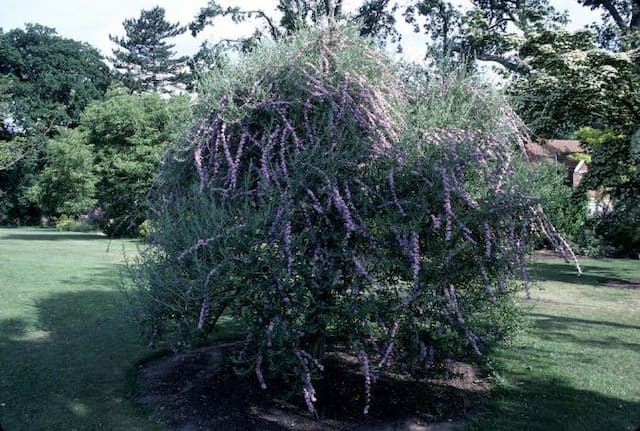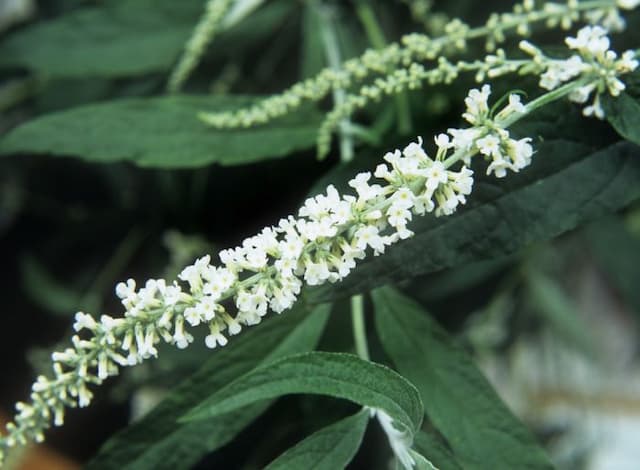Golden Butterfly Bush Buddleja × weyeriana 'Sungold'

ABOUT
Buddleia 'Sungold', commonly known as the Butterfly Bush, showcases a striking appearance characterized by its unique golden-yellow flowers. These flowers are arranged in rounded clusters that form at the tips of arching branches, creating a globe-like shape which is atypical for the species usually noted for long, conical flower spikes. The blossoms possess a honeyed fragrance which is inviting to a variety of pollinators including butterflies and bees. The foliage of the Butterfly Bush 'Sungold' consists of elongated leaves that exhibit a soft, sage green color. The leaves have a slightly fuzzy texture and are arranged oppositely along the stems, providing a lush background that contrasts beautifully with the warm tones of the blooms. Together, the golden flowers and sage green leaves provide a vivid splash of color and texture, making the Butterfly Bush 'Sungold' a standout in any garden setting where it is cultivated for its ornamental qualities and its appeal to wildlife. It is a deciduous plant, meaning it will shed its leaves in the fall, but will regrow them in the spring to once again charm onlookers with its enchanting display.
About this plant
 Names
NamesFamily
Scrophulariaceae
Synonyms
Butterfly Bush, Golden Butterfly Bush
Common names
Buddleja × weyeriana 'Sungold'.
 Toxicity
ToxicityTo humans
The Butterfly Bush is not known to be toxic to humans. However, as with any plant, individual allergic reactions or sensitivity could occur when handling or ingesting plants that are not generally recognized as edible. If such symptoms appear, medical advice should be sought.
To pets
The Butterfly Bush is not commonly listed as a toxic plant to pets such as dogs and cats. Nonetheless, it is not intended for consumption, and ingestion in significant quantities could potentially cause mild gastrointestinal upset in some animals. If a pet displays symptoms like vomiting or diarrhea after ingesting this plant, consultation with a veterinarian is recommended.
 Characteristics
CharacteristicsLife cycle
Perennials
Foliage type
Deciduous
Color of leaves
Green
Flower color
Gold
Height
5-8 feet (1.5-2.4 meters)
Spread
5-8 feet (1.5-2.4 meters)
Plant type
Shrub
Hardiness zones
5-9
Native area
Cultivar
Benefits
 General Benefits
General Benefits- Attracts Pollinators: Buddleia 'Sungold' is a magnet for butterflies, bees, and other beneficial insects, aiding in the pollination of surrounding plants.
- Aesthetic Appeal: With its bright yellow-gold flowers, Buddleia 'Sungold' adds a vibrant splash of color to any garden setting.
- Drought Tolerant: Once established, this plant is fairly drought-resistant, making it suitable for xeriscaping and low-water gardens.
- Fast Growing: It is a rapid grower, quickly providing coverage and filling in garden spaces.
- Low Maintenance: Requires minimal care once established, apart from occasional pruning to maintain shape and encourage flowering.
- Long Blooming Season: Offers a long period of blooming, typically from early summer to autumn, providing extended interest in the garden.
- Wildlife Habitat: The dense foliage and flowers provide a safe haven and food source for a variety of wildlife.
- Versatility in Landscaping: Can be used in various garden designs, including borders, butterfly gardens, and as a focal plant.
- Tolerance to Poor Soil: Able to thrive in less fertile soils, which can be beneficial for gardeners dealing with challenging ground conditions.
- Easy to Propagate: Can be easily propagated from cuttings, allowing gardeners to expand their garden or share with others.
 Medical Properties
Medical PropertiesThis plant is not used for medical purposes.
 Air-purifying Qualities
Air-purifying QualitiesThis plant is not specifically known for air purifying qualities.
 Other Uses
Other Uses- Attracting Wildlife: 'Sungold' can serve as a nectar source for butterflies, bees, and other beneficial insects, enhancing biodiversity in the garden.
- Educational Tool: This plant can be used in educational settings to teach about pollination and the importance of pollinators in ecosystems.
- Photography Subject: With its striking golden blooms, 'Sungold' makes a beautiful subject for nature and garden photography.
- Floral Arrangements: The flowers of 'Sungold' can be cut and used in floral arrangements to add a splash of color indoors.
- Hedging: 'Sungold' can be planted in a row to create an informal, flowering hedge in the garden.
- Cultural Symbolism: In some cultures, Buddleja is used symbolically in gardening to represent rebirth and new beginnings.
- Erosion Control: The dense growth habit of 'Sungold' can help stabilize soil and prevent erosion on slopes or banks in the garden.
- Privacy Screen: 'Sungold' bushes can be used to create a living privacy screen that also adds aesthetic value to the landscape.
- Artistic Inspiration: The color and form of 'Sungold' might be used by artists as inspiration for paintings, drawings, and other artistic creations.
- Companion Planting: 'Sungold' can be used in companion planting to help deter pests from more sensitive plants with its aromatic leaves.
Interesting Facts
 Feng Shui
Feng ShuiThe Butterfly Bush is not used in Feng Shui practice.
 Zodiac Sign Compitability
Zodiac Sign CompitabilityThe Butterfly Bush is not used in astrology practice.
 Plant Symbolism
Plant Symbolism- Transformation: The Buddleja, commonly known as the Butterfly Bush, is often associated with transformation due to its ability to attract butterflies, which are a universal symbol of change and metamorphosis.
- Renewal: As a plant that dies back in winter to return lush and full in spring, the Butterfly Bush symbolizes renewal and the idea of new beginnings.
- Attraction: Because of its capacity to draw in butterflies and other pollinators, the Butterfly Bush represents attraction and magnetism, making it emblematic of pulling in what one desires.
- Beauty: With its vibrant, conical blooms, the Butterfly Bush symbolizes beauty, reminding us to find and appreciate the charm in our surroundings.
- Healing: The Butterfly Bush is sometimes thought to represent healing because of its soothing presence in gardens and its role in supporting pollinators, which are crucial for ecosystem health.
 Water
WaterThe Butterfly Bush 'Sungold' should be watered deeply to ensure the root system is thoroughly moistened, with about 1 to 1.5 gallons for a mature plant, depending on the size and soil conditions. Watering should be done when the top inch of soil feels dry to the touch, which typically means once a week in the absence of rainfall or more frequently during hot, dry spells. Avoid overhead watering to prevent leaf diseases. During the winter months, reduce the frequency, as plants will require less water. Ensure the plant is in well-draining soil to prevent waterlogging, which can cause root rot.
 Light
LightThe Butterfly Bush 'Sungold' thrives best in full sun exposure, receiving at least 6 to 8 hours of direct sunlight daily. Plant it in a location where it can bask in the unobstructed light, which is crucial for blooming. While it can tolerate some partial shade, too little sun will reduce the number of flowers and can lead to leggy growth.
 Temperature
TemperatureThe Butterfly Bush 'Sungold' is fairly hardy and can survive in temperatures as low as 20°F; however, it thrives in warmer conditions. The ideal temperature range is between 60°F and 90°F. Young plants may need protection from frost, and while mature plants can handle cold snaps, they perform best when not exposed to prolonged freezing temperatures.
 Pruning
PruningPrune the Butterfly Bush 'Sungold' in late winter or early spring by cutting back the previous year's growth to about one foot above the ground. This encourages the plant to produce more flowers and maintains a pleasing shape. Remove any dead or diseased wood whenever noticed, and deadhead spent flowers regularly to promote continued blooming throughout the season.
 Cleaning
CleaningAs needed
 Soil
SoilButterfly Bush 'Sungold' thrives in well-draining soil with a pH between 6.0 and 7.0. A mix of loam, peat, perlite, and compost is ideal to maintain moisture while avoiding waterlogging. Enriching the soil with organic matter will support robust growth.
 Repotting
RepottingButterfly Bush 'Sungold' typically does not require frequent repotting as it's a large, fast-growing shrub; it may need to be repotted or planted out every few years if grown in a container to refresh the soil and accommodate root growth.
 Humidity & Misting
Humidity & MistingButterfly Bush 'Sungold' is tolerant of a wide range of humidity levels and it doesn't require any special humidity conditions. Typical outdoor humidity is generally suitable for this hardy plant.
 Suitable locations
Suitable locationsIndoor
Ensure bright light, well-draining soil, and ample space to grow.
Outdoor
Full sun, well-drained soil, and prune to encourage blooms.
Hardiness zone
5-9 USDA.
 Life cycle
Life cycleBuddleja × weyeriana 'Sungold', also known as Butterfly Bush 'Sungold', begins its life cycle when seeds are sown or cuttings are taken from mature plants. After germination or rooting, the seedlings or cuttings are transplanted into the ground or containers, where they develop a strong root system. Once established, the plant enters a vigorous vegetative growth stage, producing a dense cluster of woody stems and foliage. Throughout the spring and summer, 'Sungold' enters its flowering stage, showcasing panicles of golden-yellow flowers that attract butterflies and other pollinators. After blooming, the flowers develop into small capsules containing seeds, completing the reproductive cycle. In preparation for winter, the plant may become dormant, shedding leaves and conserving energy, ready to restart the cycle with new growth in the following spring.
 Propogation
PropogationPropogation time
Spring to Summer
The Buddleja × weyeriana 'Sungold', commonly known as Golden Butterfly Bush, can be propagated through semi-hardwood cuttings. The best time to take cuttings for propagation is during mid-summer or early fall when the plant is actively growing. To propagate, a cutting of about 4 to 6 inches (approximately 10 to 15 centimeters) is cut from a healthy, non-flowering stem ensuring it has several leaves. The lower leaves are removed, and the cut end is dipped in rooting hormone to encourage root development. This cutting is then placed in a well-draining potting medium, such as a mix of peat and perlite, watered gently, and covered with a plastic bag to maintain humidity. It is crucial to keep the cuttings in bright, indirect light and to ensure the medium stays moist but not waterlogged. With proper care, roots will typically develop within a few weeks, after which they can be gradually acclimatized to outdoor conditions.



![Butterfly bush [Florence]](/_next/image?url=https%3A%2F%2Fplants-admin.emdemapps.com%2Fimages%2Fplants%2F%2Fimages%2F604b5f52d7bb1.png&w=640&q=75)
![Butterfly bush [Nanho Blue]](/_next/image?url=https%3A%2F%2Fplants-admin.emdemapps.com%2Fimages%2Fplants%2F%2Fimages%2F604b55d0a6d2d.png&w=640&q=75)




